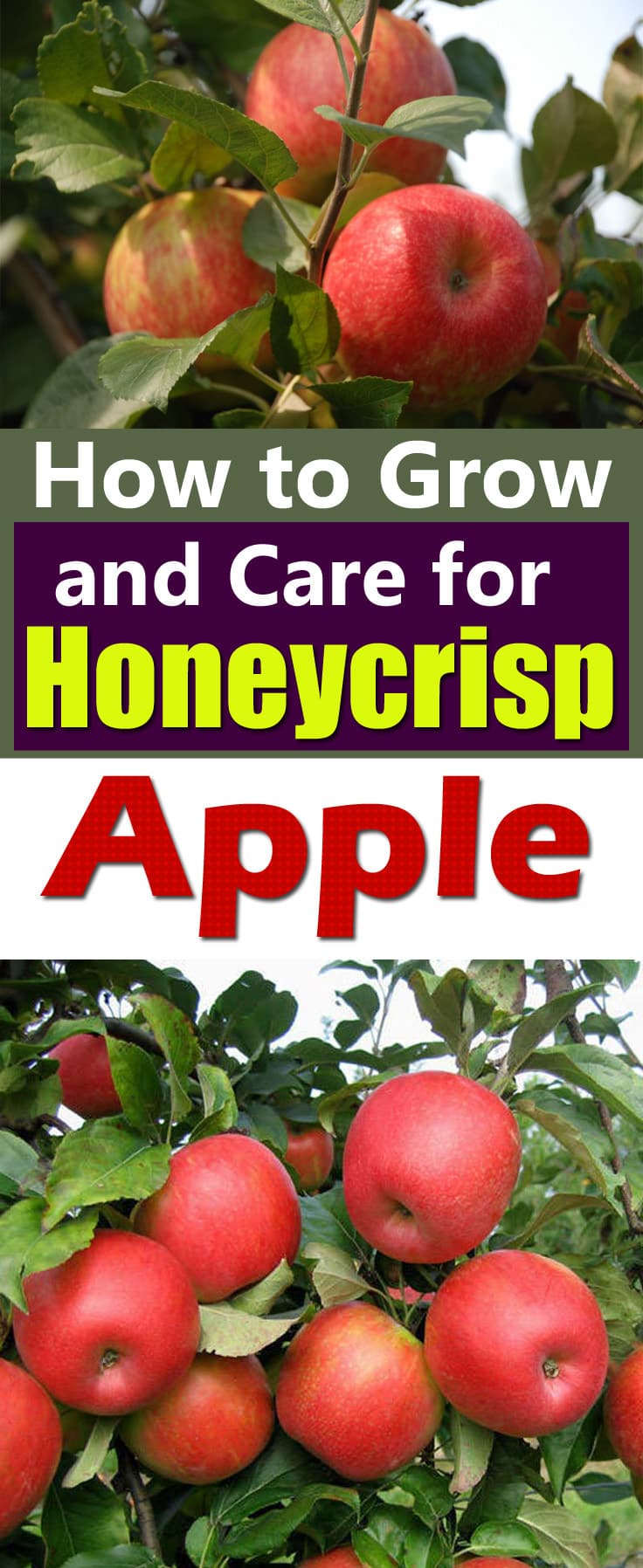By Linda Green
Learn how to grow Honeycrisp apple tree. Honeycrisp apples are growing in popularity for their exceptional freshness, sweet taste and crisp and juicy flavor. They are a cross between “Macoun” and Honeygold” apples.
Difficulty— Moderate
Soil pH— 6 – 7
Propagation and Growing Honeycrisp apples
If you are planning to grow honeycrisp apple tree, it is better to buy a grafted plant from nursery. Grafted trees are good annual bearers with increased productivity.
Spacing
Honeycrisp trees spread relatively large in compare to other apple cultivars. Without enough space they may become stunted and produce poor quality fruits.
Plant honeycrisp tree in less windy but clearest and sunniest spot of your garden, remember it must be protected in bad weather and storms as honeycrisp apple tree has relatively weak timber.
Dwarf honeycrisp trees should be planted 10 feet apart and semi-dwarf trees 15 feet away.
Also Read: How to Grow Asian Pears
Planting Honeycrisp Apple trees
Bareroot plant of Honeycrisp apple needs to be planted in spring. A grafted tree bought from nursery can be planted in spring or in fall.
Pollination
If you are growing Honeycrisp apple tree you should know it is self sterile, grow a tree or two of other apple cultivars to ensure cross-pollination and better fruit harvest. Grow pollinating tree within 50 feet range of Honeycrisp tree.
Requirements for Growing Honeycrisp Apple
Sun
For growing honeycrisp apple tree full sun is required.
Watering
Honeycrisp tree requires regular watering when it is establishing. It is important to keep the root ball moist during the first three months after planting.
Once established Honeycrisp apple tree needs water only when the soil is dry to a depth of 3 inches near the trunk of tree, the normal rainfall is sufficient to keep mature trees green.
Soil
For planting honeycrisp apples, soil should be well draining with a pH level around 6 to 7. It grows best in loamy soil: a mixture of sand, silt and light clay.
Honeycrisp Apple Tree Care
Honeycrisp apple trees are weak so you will need to acquire a trellis system to support your plant.
Mulching
Spread a ring of mulch 2 – 4 inches thick and deep and about 3 feet 6 inches wide from the beginning of the apple tree trunk. Do not allow the mulch to touch or accumulate against the bark, where it will cause rot.
Pruning
Prune your Honeycrisp apple tree when it is about 3 to 5 years old in early spring before new growth emerge. Clip off vertically growing branches, leaving 5 – 7 branches that grow horizontally to bear fruit. These branches should be spaced evenly around the trunk or central branch.
Fertilizer
Fertilize young Honeycrisp tree in its first year with 10-10-10 fertilizer, spread evenly on the soil 6 inches away from tree’s trunk in early spring.
For mature trees it is best to get your soil tested before fertilizing for best results.
Thinning
Honeycrisp apple tree requires extensive thinning to produce quality fruits. If all apples are allowed to stay on the tree, the result is low-quality fruits with poor color. The tree can also be deformed or even have branches break down from the half since the Honeycrisp apple tree tends to produce large, heavy fruits.
Thinning should happen when apples are about half an inch in diameter. Either do it by hand or using chemical solvents. Honeycrisp apple tree should not have more than 24 fruits per inch of trunk diameter.
Harvesting
Harvesting of Honeycrisp apples begins around late august to september. Best way to determine if apples are ready for harvest is to taste one. The longer the apples remain on the tree, the more crisp and sweet they become.
Also Read: How to Grow Strawberries
Pests and Diseases
Unfortunately honeycrisp apple trees are not resistant to most of the apple diseases albeit they are more susceptible, especially to rust juniper, black rot, cedar apple rust, fireblight, and penicillium.
In pests, honeycrisp apple tree can be attacked by codling moths, leafrollers, aphids and scales. They are also prone to powdery mildew.




Thank you!!!
My honeycris grew well this summer and has quite a bit of verticals. What would happen if I trim back now?
My honey crisp is 6 years old but never bore a fruit. It is in sunny spot. What’s wrong? And what should I do to get apples from it?
Natasha, do you have additional trees nearby (or a hybrid tree) to ensure cross pollination? I’ve been selling the neighbors on planting, but if not, I intend to graft a couple branches of Pink Lady as an additional cultivar.
My honeycrisp produces beautiful large apples. But they rot on the inside before they are picked.
Planted a couple of Honeycrisp Apple trees this spring. 1 tree looks healthy with some spots on ots leaves. The leaves on the 2nd look lighter with spots on them. I know the soil isnt the best, but is there something else I can do?
Whey do they rot like that from the inside. How can it be prevented
bruh this is some gud info
Hi
We planted 10 honey crisp last year they look great but have no fruit
Have 5 Harolds they are producing
What can we do
You need a cross pollinator. Honeycrisp are not self-pollinators. Look up what is a pollinator for the Honeycrisp and pick one to plant nearby.
My honeycrisp tree is 8 years old and has never produced a full sized apple. I get a ton of tiny apples the size of a large pea and they stay that size and green throughout the entire growing season. Does the tree need a hard pruning?
You don’t have a honeycrisp. most likely the root stock grew rather than the graft. Get a friend to graft to your tree